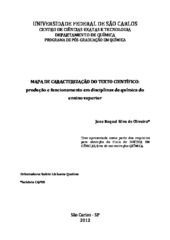Mapa de caracterização do texto científico : produção e funcionamento em disciplinas de química do ensino superior
Abstract
The main objectives of this research were to develop and to implement a tool ‐ the Characterization Map of Scientific Text ‐ which could assist students in recognizing the structural and rhetorical aspects of the scientific language and to investigate its functioning as a facilitator in improving scientific writing of undergraduate chemistry students and as a scientific texts analysis tool. We adopted the theoretical studies of Latour, Coracini, and Campanario on the rhetoric aspects of scientific articles and the studies of Oliveira and Queiroz on the structural aspects of scientific texts in the chemistry field. We analyzed the main characteristics of the scientific language and elaborated the categories of analysis of the scientific text structural and rhetorical elements, as well as the Preliminary Characterization Map of Scientific Text. We also developed didactic materials about the structural and rhetorical aspects of scientific texts, which were applied in higher education chemistry courses. We analyzed the written production of students in activities about rhetorical aspects using peer review. We analyzed the final scientific texts (reports and miniarticles) written by the students and scientific articles written by researchers in the chemistry field. We also investigated the criteria used by professors in the evaluation of scientific texts assigned related to the courses. From these results we developed the Final Characterization Map of Scientific Text, including considerations reported in the studies of Kelly and Takao, Zohar and Nemet, and Sandoval and Millwood. We also developed didactic material about this final Map, which was applied in a different class. We analyzed the initial and final texts produced by the students of this class, as well as their responses to an evaluation questionnaire about the activities based on the Map under consideration. In the activities about the rhetorical aspects, the students developed skills to recognize and analyze critically such strategies in the scientific texts. In the peer review activities, although some rhetorical aspects were also mentioned, the students focused on the structural aspects of the scientific texts. The texts written by the students showed few rhetorical resources compared to those written by researchers. Although considering some rhetorical aspects, the professors focused on structural aspects in the evaluation of scientific texts assigned related to the course. From the activities based on the Final Characterization Map of Scientific Text, the students understood how the scientific text is structured and strengthened, and they improved their scientific writing using structural and rhetorical elements adequately in written texts.
